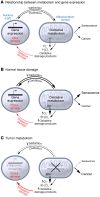Emerging evidence for targeting mitochondrial metabolic dysfunction in cancer therapy
- PMID: 30168803
- PMCID: PMC6118595
- DOI: 10.1172/JCI120844
Emerging evidence for targeting mitochondrial metabolic dysfunction in cancer therapy
Abstract
Mammalian cells use a complex network of redox-dependent processes necessary to maintain cellular integrity during oxidative metabolism, as well as to protect against and/or adapt to stress. The disruption of these redox-dependent processes, including those in the mitochondria, creates a cellular environment permissive for progression to a malignant phenotype and the development of resistance to commonly used anticancer agents. An extension of this paradigm is that when these mitochondrial functions are altered by the events leading to transformation and ensuing downstream metabolic processes, they can be used as molecular biomarkers or targets in the development of new therapeutic interventions to selectively kill and/or sensitize cancer versus normal cells. In this Review we propose that mitochondrial oxidative metabolism is altered in tumor cells, and the central theme of this dysregulation is electron transport chain activity, folate metabolism, NADH/NADPH metabolism, thiol-mediated detoxification pathways, and redox-active metal ion metabolism. It is proposed that specific subgroups of human malignancies display distinct mitochondrial transformative and/or tumor signatures that may benefit from agents that target these pathways.
Conflict of interest statement
Figures


References
-
- Wei YH, Ma YS, Lee HC, Lee CF, Lu CY. Mitochondrial theory of aging matures — roles of mtDNA mutation and oxidative stress in human aging. Zhonghua Yi Xue Za Zhi (Taipei) 2001;64(5):259–270. - PubMed
-
- Houstek J, Pícková A, Vojtísková A, Mrácek T, Pecina P, Jesina P. Mitochondrial diseases and genetic defects of ATP synthase. Biochim Biophys Acta. 2006;1757(9–10):1400–1405. - PubMed
Publication types
MeSH terms
Substances
Grants and funding
LinkOut - more resources
Full Text Sources
Other Literature Sources

